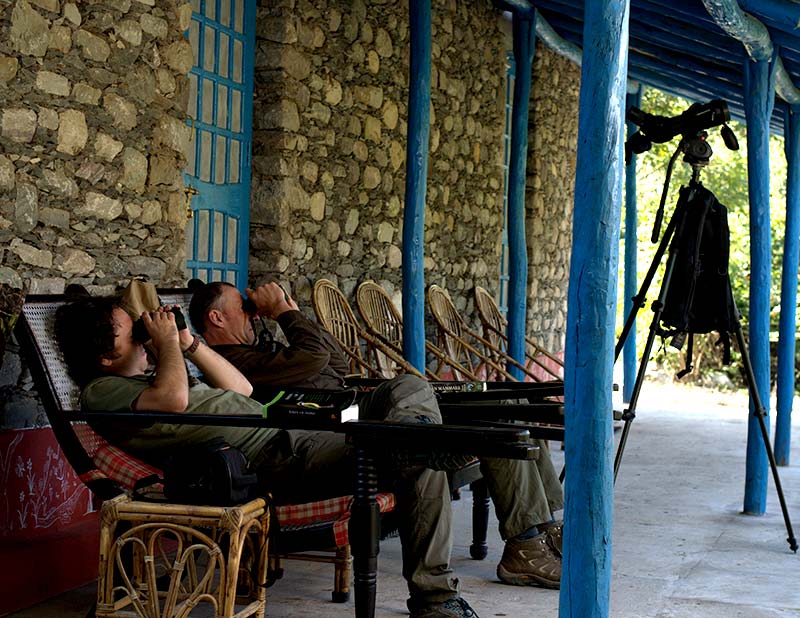Who We Are
Our Vision
The name Vanghat is made of 2 Hindi words: ‘van’ (jungle) and ‘ghat’ (valley), and the name describes the surroundings very well. To keep this area in its natural form and protected from ‘development disease,’ the lodge was created in 2006 with the aim of inviting nature lovers, wildlife enthusiasts, conservationists, and sustainable-life practitioners.
We vision Vanghat as a setting that
- Provides jungle experiences without disturbing wildlife
- Practices sustainable life-style & community-based conservation
- Promotes responsible tourism
- Hosts wide varieties of flora and fauna
- Facilitates a meaningful learning environment for children
- Creates awareness about human and environmental health
Our Team
Our team is entirely local, and our gracious hosts possess the hill folks’ fine traits of politeness and hardiness, whilst also knowing the surrounding landscape and wildlife better than anyone. Our activities, focused on walking safaris (a rarity in tiger country), birding, wildlife photography, and angling are led by some of the finest knowledgeable naturalists and guides in the area. Creative activities, facilitated by various artists and wellness programmes, are conducted by healers/health practitioners. Our menus are prepared by healthy-cooking experts, and include local traditional meals, as well as continental food.
Our Story
Modest, traditional, and in many ways ahead of its time, in true Corbett fashion.
Today returned to wilderness, Vanghat was once the site of a thriving village. Its history dates back to the turn of the twentieth century when early settlers were brought in by the British for employment in the timber industry, evidence of which can still be seen up-valley above Marchula. Thankfully, the forest from Vanghat and beyond for around 60km to Kalagarh fell under strict protection even then as it was the grounds for the Viceroy and Governor General of India's grand annual hunt.
It was under the stewardship of the legendary hunter-turned- pioneering conservationist, Jim Corbett, that this area became Asia's first national park, founded in 1936 and later renamed in his honour. In 1974, Jim Corbett National Park was chosen as one of the launch areas for Project Tiger, securing the park and Jim's legacy at the forefront of wildlife conservation. The area of the reserve increased over time, including the creation of the Corbett and Kalagarh Tiger Reserves in 1991, to act as a buffer zone to the national park. This enveloped many small settlements in the area, including the village at Vanghat.
By this time however, the settlement, once a typical small Brahmin village whose inhabitants largely depended on agriculture and forest produce, fertile land, and proximity to the Ramganga River, had been largely abandoned due to monsoon flooding, with its youth moving to more promising urban prospects.
When lodge owner and founder Sumantha Ghosh first came upon the land in 1999, he was then the chief naturalist at Tiger Tops Lodge, exploring remote submontane river systems for a fishing camp with waters deep enough for giant Mahseer to migrate up year-round. The ecosystem was in a bad way. The waters were uninhabited by the once legendary Golden Mahseer, due to locals who fished with explosives and chemicals, and the land a degraded and overgrazed patch between the protected forest and the river. But it showed enormous potential and was surrounded by great beauty, so much so that Sumantha decided to purchase the land for himself.
Initial efforts to regenerate the river were rapid and remarkable. By setting up a scheme that shared revenue from game fishing with the local communities thus making it in everyone's interest to protect the river, within a year our stretch of the Ramganga boasted some of the finest Mahseer fishing beats anywhere. Concentrated efforts were also made to restore the land and the wildlife returned. With every year of growth that passes, it becomes ever more indistinguishable from the tiger reserve that surrounds us.
The property was earlier meant to be a private fishing spot for close friends and family and a charming stone cottage was constructed. However, disconcerted with the state of popular tourism in India’s national parks, Sumantha chose to expand the lodging and built four mud and thatch bungalows, thus creating a rich experience for true wildlife enthusiasts that was not detrimental to the landscape or fauna and at the same time supported local communities through gainful employment. Vanghat is modest, traditional, and in many ways ahead of its time, in true Corbett fashion.
Today Vanghat stands humbly at the forefront of sustainable tourism within the subcontinent, one of few lodges enthusiastically welcoming the Government of India's strict guidelines for ecotourism enacted to curb rampant tiger tourism which, as Sumantha had foreseen, has proved untenable. Of course there is still work to be done and we will continue to strive to make our operation as environment friendly and socially responsible whilst providing our guests with an unparalleled time in the Indian wilderness.
Signup for our Newsletter
Know whats happening.





